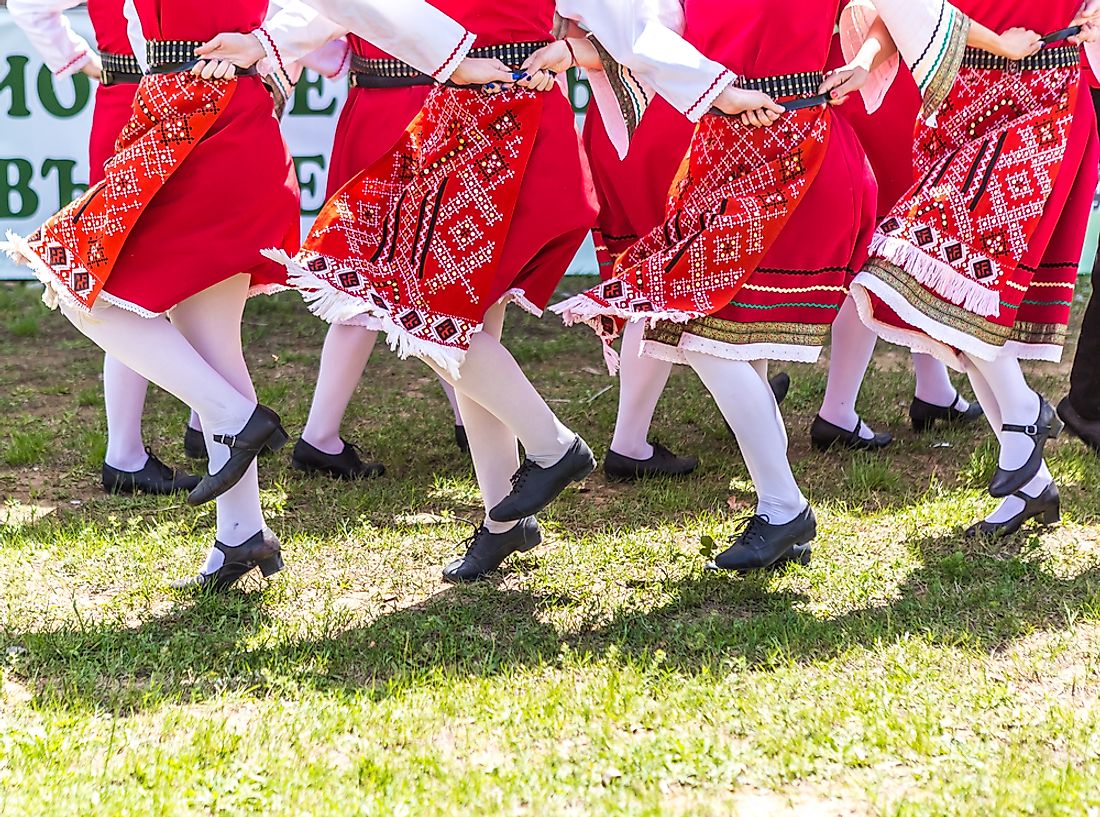The Culture Of Bulgaria

The Southeast European country of Bulgaria houses a population of around 7,057,504 individuals. Ethnic Bulgarians account for 76.9% of the total population of the country. The Turkish and the Romani ethnic groups are the largest minority ethnic communities. Bulgarian is the official language spoken in the country. The majority of Bulgarians (59.4%) are affiliated to the Eastern Orthodox Church. 7.8% of the population comprises of Muslims.
Cuisine
Bulgarian cuisine represent Eastern European cuisine. It features both local and international dishes, especially Turkish, Greek, and Persian dishes. Salads are often eaten as appetizers. Soups and pastries are important components of Bulgarian cuisine. The cold soup tarator (salted strained yogurt or diluted yogurt with added garlic, olive oil, cucumbers, and some herbs) is a popular dish. Meat, chicken or vegetarian stews are consumed as the main course. Although deep frying is not preferred, grilling is a common technique used to cook foods like sausages. Baked filled pastries called börek and filo dough based banitsa are also widely consumed. Bulgarians are top yogurt consumers in Europe. Special occasions demand traditional meals. On Christmas Eve, cabbage leaf stuffed dishes called sarmi and vegetarian stuffed peppers are eaten. Cabbage dishes are also commonly consumed on New Year's Eve. Fish, usually carp, is eaten during Nikulden. The Bulgarians also love to consume wines and other alcoholic drinks like the rakia (fruit brandy).
Literature And The Arts
Bulgarian literature began in the latter half of the 9th century with the spread of literacy in the Old Bulgarian language. Most of the early literary works were religious in nature. Secular writings started appearing many centuries later in the late 18th century. By this time, modern vernacular Bulgarian was in use. Historical writings now started appearing. The modern standard Bulgarian language developed in the early 19th century and literary works flourished henceforth. Folklores were now collected and published by ethnologists.
The early graphic arts scene of Bulgaria featured paintings of a religious nature. Fresco painting was popular during this time. Bulgarian frescoes like those in the Boyana Church near Sofia are internationally recognized for their beauty and detail. Wood carving, weaving, other textile arts, and ceramics are some of the well-established crafts of the country.
Performance Arts
Bulgaria has a rich heritage of music, dance, and theater. The music and dance of the country range from folk to classical and jazz, pop, and rock. The country’s indigenous wedding band music and women’s choral music are internationally famous. The Romani people living in the country have their own folk cultures which add to the wealth of the Bulgarian folk performance arts scene. Bulgarian cinema has also made great strides in the world of global cinema.
Sports
A variety of sports are played in the country. Bulgarian athletes have participated in the Olympic Games since 1896. As of 2012, the country has won 215 Olympic medals including 51 gold medals. Association football is Bulgaria’s most popular sport and the country has its own Bulgarian league. The national football team of Bulgaria has achieved some success with the biggest one being when it finished at the 4th position in the 1994 FIFA World Cup. Bulgaria also has one of the best volleyball national teams in Europe. Other sports that are popular in Bulgaria include rugby, rhythmic gymnastics, wrestling, swimming, karate, judo, etc. Bulgaria also has a national cricket team.
Life In Bulgarian Society
Although Bulgarian society was historically largely patriarchal in nature, the status of women in the country changed significantly during the socialist era. Many women entered the country’s workforce during that time. Today, Bulgarian women enjoy many rights and privileges as enjoyed by men. They can vote and own property. They also hold jobs in various fields. However, a large section of the women, especially those in rural areas, are still expected to shoulder the responsibilities of household management and childcare while men are regarded as the primary breadwinners. Also, there are fewer women in the higher employment ranks than men.
Marriages in Bulgaria are generally based on individual choice while in certain cases, family members might be actively involved in selecting the spouse. Monogamous relationships are the norm. Inter-ethnic and inter-religious marriages are not very common in the country. Most adults marry, typically in their 20s. Divorce is less stigmatized today than in the past.
Families in Bulgaria are usually small consisting of parents and children, and occasionally, grandchildren. Most couples have one or two children. The patrilocal residence where the couple moves in with the husband’s parents is more likely than the matrilocal residence. Property is usually inherited equally by all children, both male and female. Schooling is free and compulsory to a certain level.
A very interesting etiquette of Bulgarians can be observed in the way they say "yes" and "no". In the former case, they shake their head sideways while in the latter case, they make a short upward and downward movement of the head. Bulgarians are known to be great hosts. Any visitor is greeted by shaking hands and then invited into the home and offered food and drinks. The younger people are expected to show their respect to the older generations by greeting them well and speaking in a polite manner. They are also expected to give up their seat in public transport to an elderly person.











